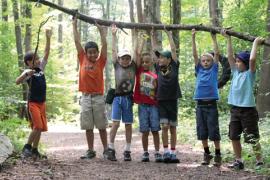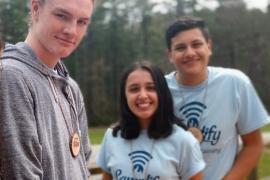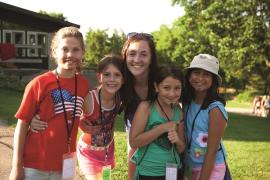The Dig and Discovery: Can We Tell the Story?
So, what is new? What is old? What is the same? Maybe everything; maybe nothing. Many times in the past, I have shared the concepts you will find in this article. You, as camp professionals, have argued these points for many more years. We, as a camp community, have been advocating for children, youth, and families for 150 years. Yet, what is our narrative? We all seem to be talking, but what are we really saying?
If an archeologist were to unearth our buried time capsule, what story would be told? What tells our history also informs our future. Let's consider what might be discovered if one placed the shovel into the dirt:
- Balls, bats, canoes, paddles, bunks, life jackets, helmets, tree stumps circling fire pits, skis, boats, floats, climbing gear, clay and ceramic sculptures, clumps of yarn and rope, and millions of string bracelets
- Names and dates carved in trees, buildings, stones, blocks of wood, and totem poles
- A plethora of moldy books called the Accreditation Standards for Camp Programs and Services
- Trails, ramps, sign posts, zip lines, pulleys, fossil prints of footprints, thousands of footprints of all sizes going in all directions, and slogans on walls
- Countless fragments of old T-shirts, popsicle sticks, frisbees, feathers, and animal skeletons
- Remnants of artifacts that appear to look like chapels or places of respite, and a cornucopia of religious and spiritual symbols
Would these artifacts tell our story? Or would they look like any other story? Would they leave archeologists confused? Many would, in fact, be befuddled — certainly curious — but confused nonetheless.
Often, I fear, without a clearly articulated oral narrative, our story, left to objects, may confuse others. When in truth, for every remnant pile of assorted camp paraphernalia, we have millions who have acquired new skills, a sense of self-mastery, and confidence. Names carved in wood or left scribbled on camp walls represent people who felt a sense of friendship, acceptance, positive identity, and camaraderie. The moldy forms and papers strewn about illustrate the tremendous diligence that was spent to ensure campers were healthy and emotionally and physically safe. Trails, zip lines, and ramps encouraged physical activity and participation, helping campers learn important life skills that led to future active and productive lives. Items such as feathers and animal skeletons suggested discovery and increased awareness of nature and the value of life. Spiritual and moral development is explained by both the spiritual places and symbols.
The archeologists would find spaces carved out for solace, thinking, contemplation, and reflection, or even just scraps of T-shirts, all of which illustrate an environment that served as a community — a community that was dedicated to the positive growth and development of children, youth, and adults. Our objects help us deliver the magic, but our professional competencies and intentionality secure the legitimate impact and outcomes participants receive from the camp experience. You see, our message is both complex and simple. In a world confounded by so many messages, today, maybe more so than yesterday, we must achieve clarity. We cannot afford to add to the confusion, but instead, we must resonate in a meaningful way to those who are bombarded with the deafening sounds of multiple, competitive messages.
Navigating the Complexity to Greater Relevance: An Age-Old Theme for the Camp Community
Those that envisioned the camp experience 150 years ago understood life was becoming more complex, and that people, particularly children and youth, were losing opportunities to grow and learn in the out-of-doors — man's best classroom. Our ability to navigate an increasingly complex and demanding world continues to challenge the camp community to discover and articulate our relevancy based on today's realities. Without a doubt, this challenge is both daunting and emotional. Any worthy vision for the future is clutched by passion.
As we have noted in the past, recalibrating relevancy and value in today's environment requires that we reposition ourselves in the world. It is not enough to talk about "camp." We have to talk about camp in relation to people and a changing society. We have to talk about camp as it relates to the experience itself. It is not enough to talk about "fun and recreation." We must articulate impact, outcome, and the value-added skills gained through the camp experience. And it certainly is not enough to simply open our doors and wait for people to join us; there are too many doors, and just as many invitations clamoring for attention.
Something Larger: Greater Good
Yet, people want to belong to something larger. At the same time, people want to feel important and want to know what they are doing has intrinsic worth. Such elements of desire and demand are what drive successful movements. In the 1940s, the American Camp Association (ACA) and the camp community became a part of a movement when we joined the recreation movement. Today, we have an opportunity to be part of an education movement. When one glances in the rearview mirror, he or she will find that the reasoning for this movement is not all that different than what lead to the emergence of the camp community 150 years ago: ensuring the basic needs of humans, particularly those related to youth development. If one looks closely, you will find patterns of familiar meaning in the disorder and disruption of today that many of us feel. If we reframe these current threats and recast them as patterns of purpose, we will find opportunities.
Amid the chaos and ambiguity that we talk about each day, our values serve as our ballast. Our principles of positive child, adolescent, and human development remain true and constant. It is what we know and what we have learned about our profession over the past 150 years that secures our time-tested purpose. We have programs and services of great import that nurture and embrace learning. We are once again a part of the solution.
We have the opportunity, and perhaps, a moral and social responsibility, to ensure an increasing number of children, youth, and adults benefit from the unique lessons learned through the camp experience. However, today with so many competing voices, we must articulate our usefulness and meaning with greater clarity. As it was 150 years ago, the camp experience is one that helps make the world and people better. Parents intuitively know their children need life experiences that teach them how to have authentic relationships and learn life habits that strengthen health and wellness, and that the connection to our primary life system, the ecosystem, is the best classroom in the world. Yet, who gives permission or advocates for such fundamental lessons that establish the foundation for emotional, social, and academic success? We must ask ourselves: If not us, who?
Resistance or Abundance: An Important Choice
Our approach cannot be one of resistance or fear, but a philosophy of abundance. People today want proof — permission, if you will — to do what they instinctively know is best. Unlike 150 years ago, today we have evidence-informed data that illustrates, articulates, and demonstrates the legitimacy of the camp experience as it relates to learning and development. We can tell magical stories supported by sound research. It is our responsibility to be knowledgeable of and advocate for such merit with others. We can justify a parent's belief that it is a good use of their child's time to be at camp. The value of the camp experience speaks to the reality of the competition for time and resources that we are confronted with on a daily basis. We can meet the test of credibility. I believe credibility combined with magic is a great formula for success.
In a recent camp-school partnership survey conducted by ACA, over 34 percent of the respondents said they were working directly with schools. Camps across the country are partnering with schools and parents in order to meet identified educational standards by using time- and research-tested experiences in the camp environment. The camp community is a group within society that has linkages and interactions that serve the greater good. The camp and school should see themselves as parts of a larger system, one that is united and dedicated to the development of children and youth. Camps and schools that partner create a whole system that is embraced by a semi-permeable membrane that allows children and families to cross seamless boundaries of symbiotic value. Children are not fragmented pieces to be doled out across a splintered landscape of youth development "providers." Effective systems hold multiple and complex entities, but serve the whole; and as a camp community, we should certainly understand the interdependence of camp and school and appreciate the fact that these elements must work together to meet the needs of humanity.
In a world in which half the population is under the age of twenty-five, we must recognize the need to make things happen, overcome our fears, and help others succeed. We are a part of the solution. We are a part of the future because we make a difference in the lives of others. We are not defined by our objects, but by our outcomes; and it is with this in mind that we should share our story.
Peg L. Smith is the chief executive officer of the American Camp Association. She can be reached at 765-349-3317. Visit www.ACAcampsblog.org to read Peg's blog.



